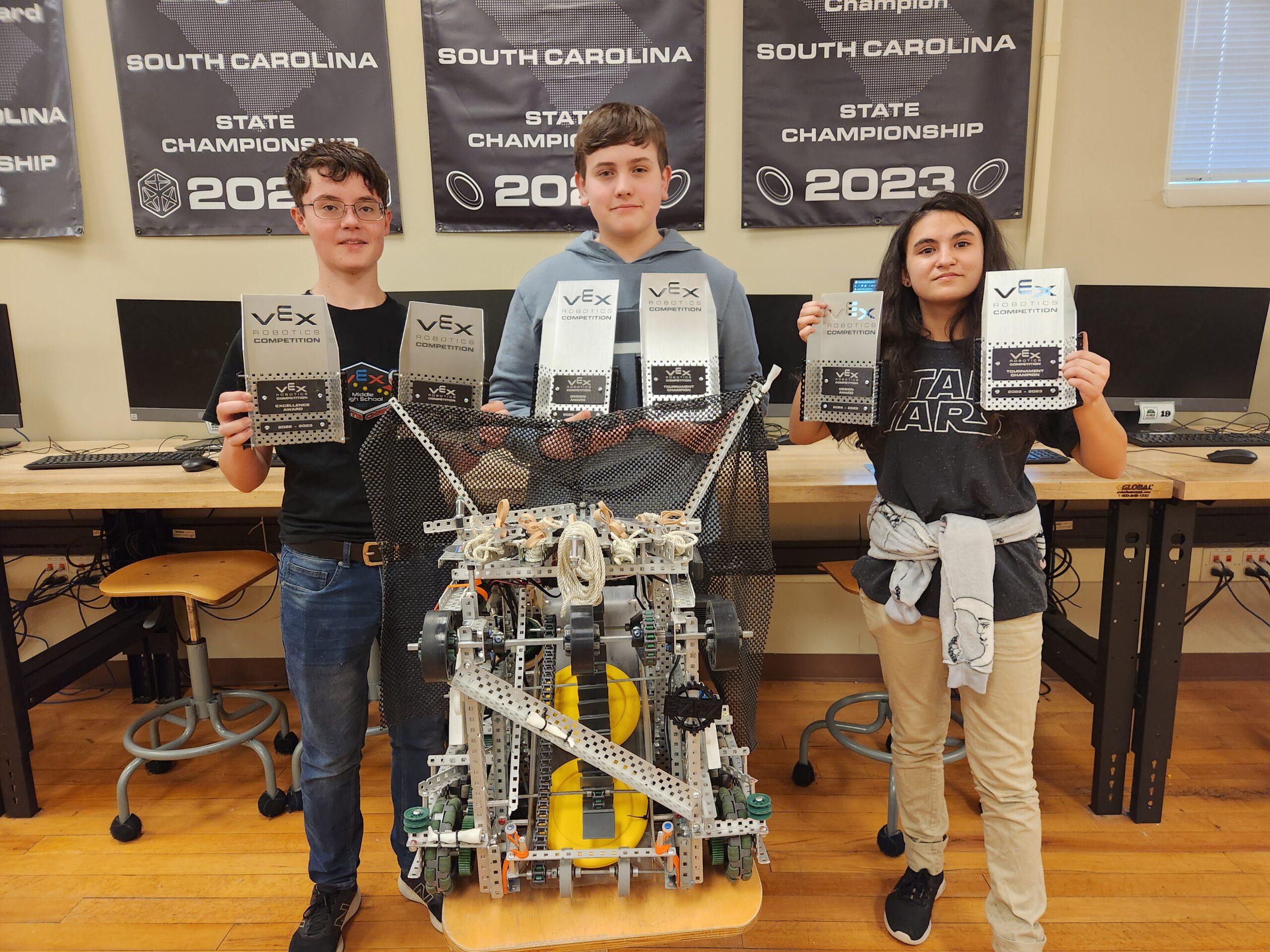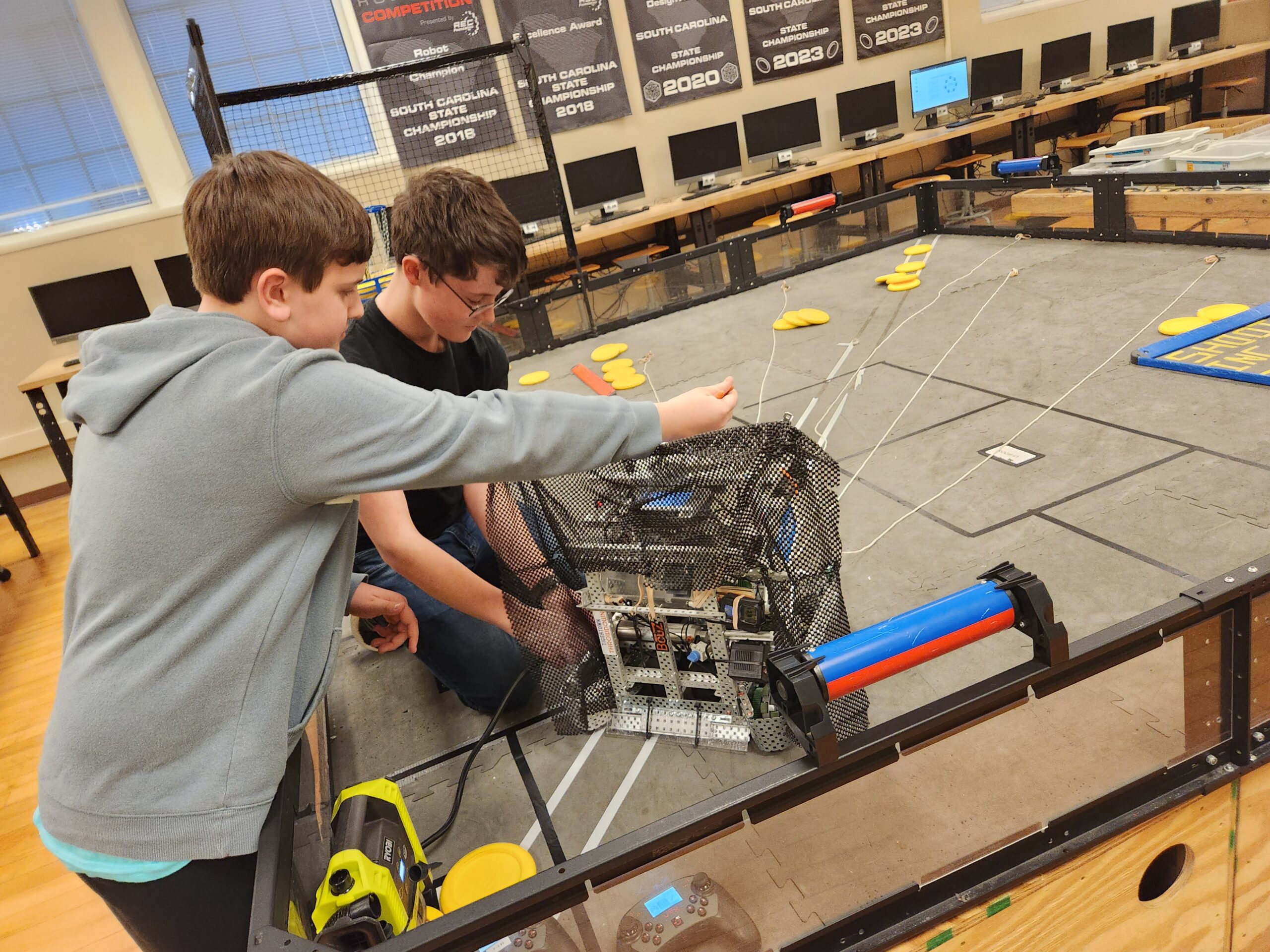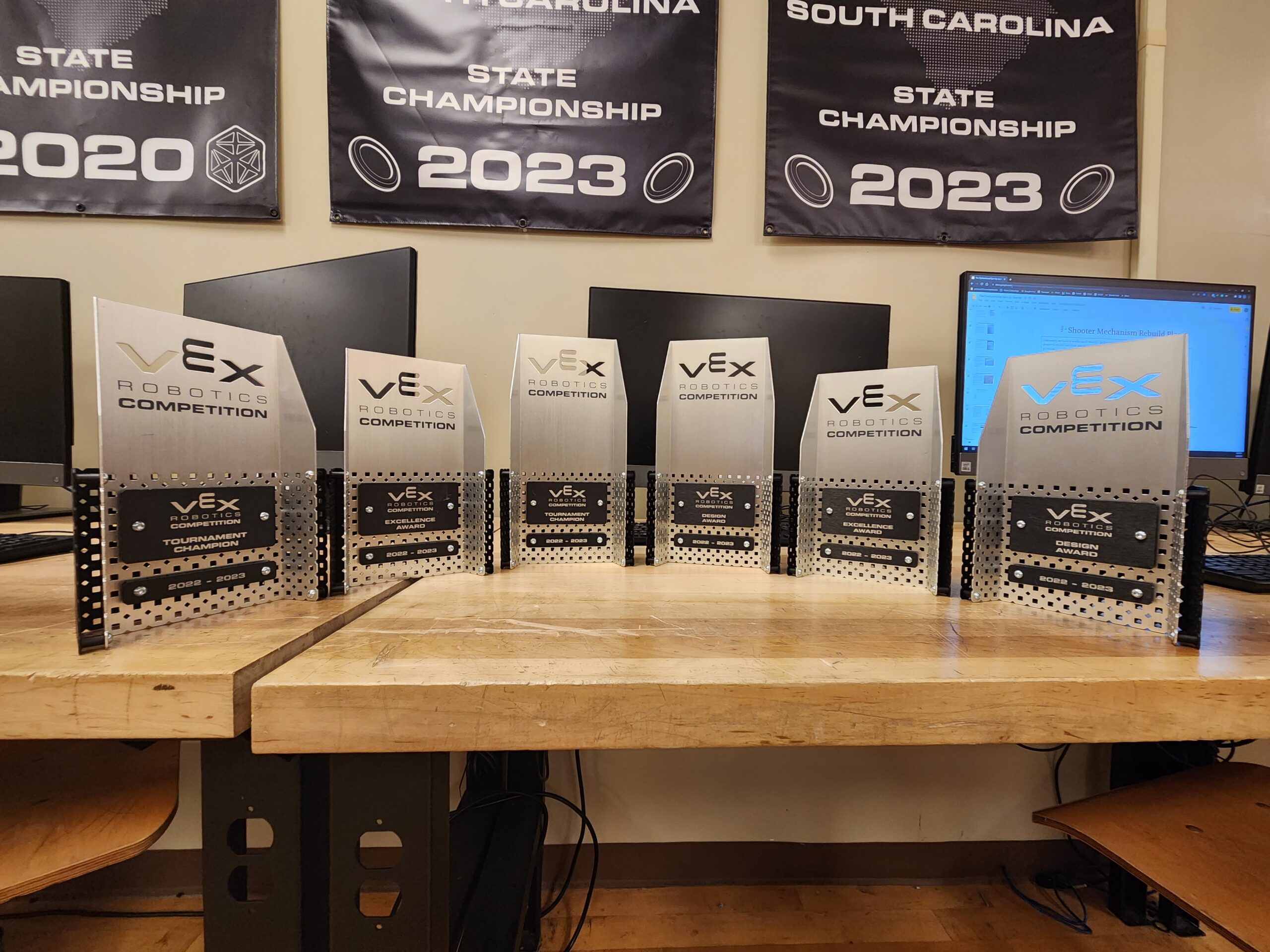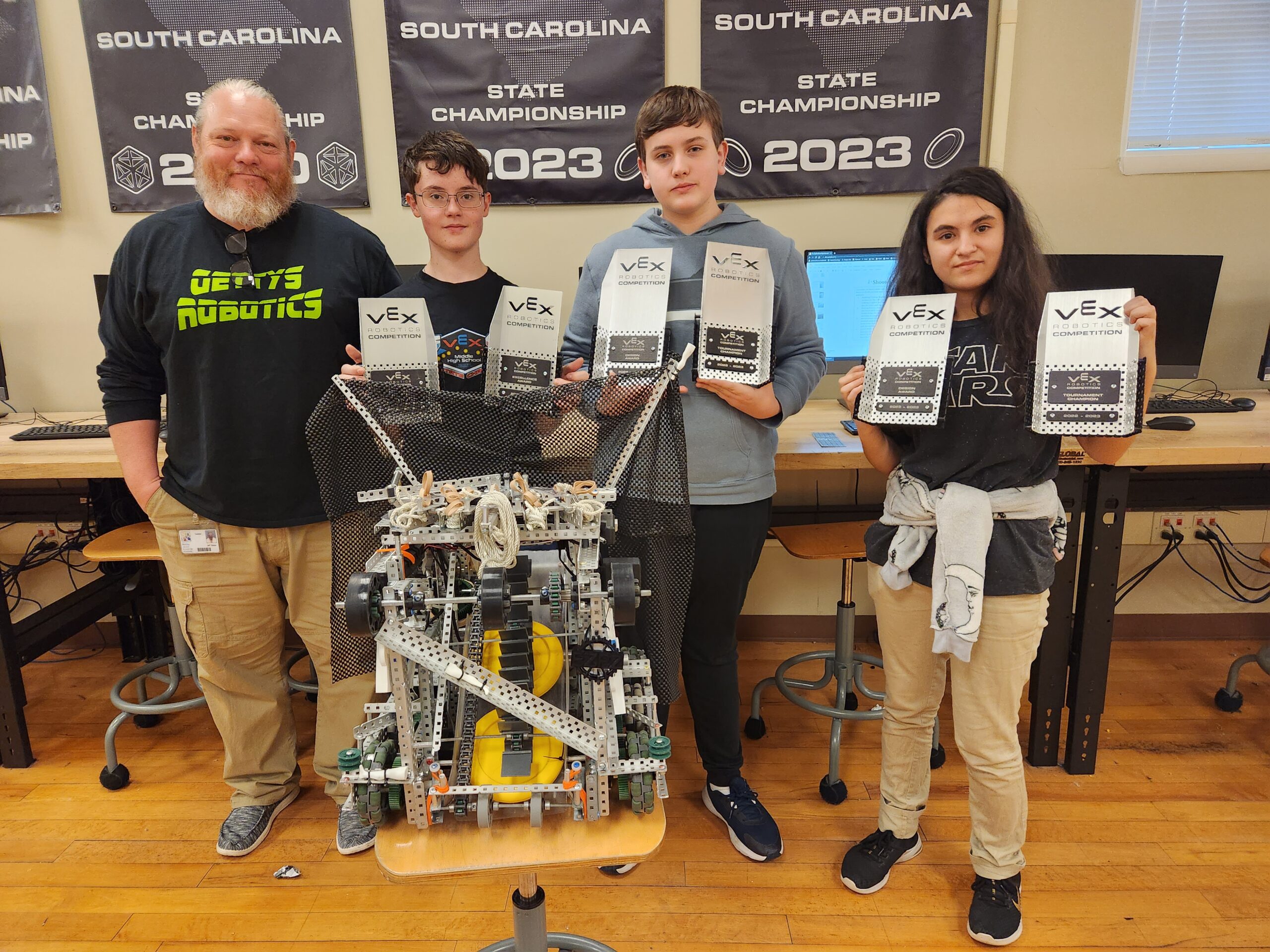

A team of 3 students is heading to Dallas, Texas at the end of April to compete in the largest robotics competition in the world, The VEX Robotics World Championship. The team of 8th graders qualified for the tournament by winning the 2023 State Championship in Columbia on March 4th. GMS is one of only a few public schools competing against some of the most elite private schools and academies around the country.
Advancing to the world competition is Team 77240G which consists of: Calder Adams, Kathrin Patterson, and Wyatt Reeves. Each one has defined roles and responsibilities within the group. Kathrin is the Lead Notebooker, Scout, Builder, and Backup Programmer. Wyatt is the Lead Builder, Notebooker, Driver, Diplomat/Lead Scout. Calder is the Builder, Notebooker, Lead Designer, Driver, and Lead Programmer.
The team members are required to design, build, program, and compete with their robot. They also have to closely document and present their entire process to the judges in competition interviews, hence the shared role of “notebooker” led by Kathrin.
There is a lot of ambiguity built into the robot parameters which allows the students a lot of room to be creative in their design process. For example, no part of the robot can ever exceed 24″ above the floor regardless of its orientation. So, the throwing mechanism can’t swing out over the robot vertically like an arm.


Grossly oversimplified, the winning design by Team 77240G is a roughly 18″ cube that rolls around like a Roomba picking up yellow discs, and launching them into the basket using a flywheel mechanism. On one side is a bar with 3 wheels attached to the drivetrain that spins the Spin Up field rollers when the robot backs up to them. For the finale, strings launch out of the top and sides to cover a dozen squares on the field, giving them a massive edge over their competition. The robot has been evolving over the past 30 weeks, and the team still has several things they hope to improve before the competition begins on April 27, 2023.
The “Game”, or VEX Robotics Competition Spin Up, that the robot is to be built for in the 2023 season is played on a 12’x12’ square field configured as seen below. Two (2) Alliances – one (1) “red” and one (1) “blue” – composed of two (2) Teams each, compete in matches consisting of a fifteen (15) second Autonomous Period, followed by a one minute and forty-five second (1:45) Driver Controlled Period.
The object of the game is to attain a higher score than the opposing Alliance by Scoring Discs in Goals, Owning Rollers, and Covering field tiles at the end of the Match.
There are sixty (60) Discs and four (4) Rollers on a VRC Spin Up Field. Discs can be Scored in the two High Goals, one per Alliance, at opposite corners of the field. Each Disc scored in a High Goal is worth 5 points. However, Robots aiming for the High Goal had better be accurate! Because underneath each High Goal, is a 1-point Low Goal for the opposing Alliance.
In addition to Discs, Robots can also spin the four Rollers mounted to the field perimeter. If the area inside of a Roller’s pointers only shows one color, that is considered “Owned” by that Alliance. Each Owned Roller is worth 10 points.
As the clock winds down, it’s time for the Endgame. At the end of the Match, Alliances will receive a 3 point bonus for each tile their Robots are Covering. So, during the last 10 seconds of the Match, there are no horizontal expansion limits.
The Alliance that scores more points in the Autonomous period is awarded with ten (10) bonus points, added to the final score at the end of the match. Each Alliance also has the opportunity to earn an Autonomous Win Point by scoring at least two Discs in Alliance’s High Goals, and owning Both Rollers on their side of the field. This Bonus can be earned by both Alliances, regardless of who wins the Autonomous Bonus
The team participated in 6 competitions so far this season. January 7, they were awarded the Design Award at the JL Mann Competition for having the best notebook. At the PCTC Competition on Jan 14, they were named Tournament Champions and were chosen for the highest award, the Excellence Award. On January 21, they won the Excellence Award again at the Walhalla Competition, and again on February 11 at the Anderson University Competition. On March 4th at the SC State Championship in Columbia, they double qualified for the World Championship by winning Tournament Champion and Design Awards.


Historically, Getty’s robotics teams are world-class competitors. Teams qualified for the State Championship in the last 7 years*, the National Championship the last 4 years*, and the World Championship in 2017, 2018, 2020, and 2022 (*they did not compete in 2021 due to COVID).
In the 2019 Season, they won the most awards in a single season in GMS history with 5 total, including 3 wins!
In the 2020 Season, the robotics team won the Spark Award and the Excellence Award in the Regional Tournaments. They won the Design Award at the State Championship, and out of over 20,000 teams worldwide from 50 countries, they finished in the top 100.
In the 2022 season, they once again beat their own record of awards and win totals. Three teams qualified for the State Championship. Two teams qualified for the National Championship. One team competed in the World Championship in Dallas, Texas. That team advanced to round 16 in their division before being beaten by the team that had won the National Championship. Still, no team from SC advanced further than GMS Robotics!
GMS Robotics, led by Jeff Tharpe for the last 6 years, is much more than a STEM program. It does more than just teach students computer science concepts along with the engineering and mechanical design process. The primary mission is to help teams gain meaningful experience and understanding of innovation, collaboration, critical thinking, communication, creativity, and citizenship. He believes these are important “soft skills” that empower each student for college, career, and life success.


